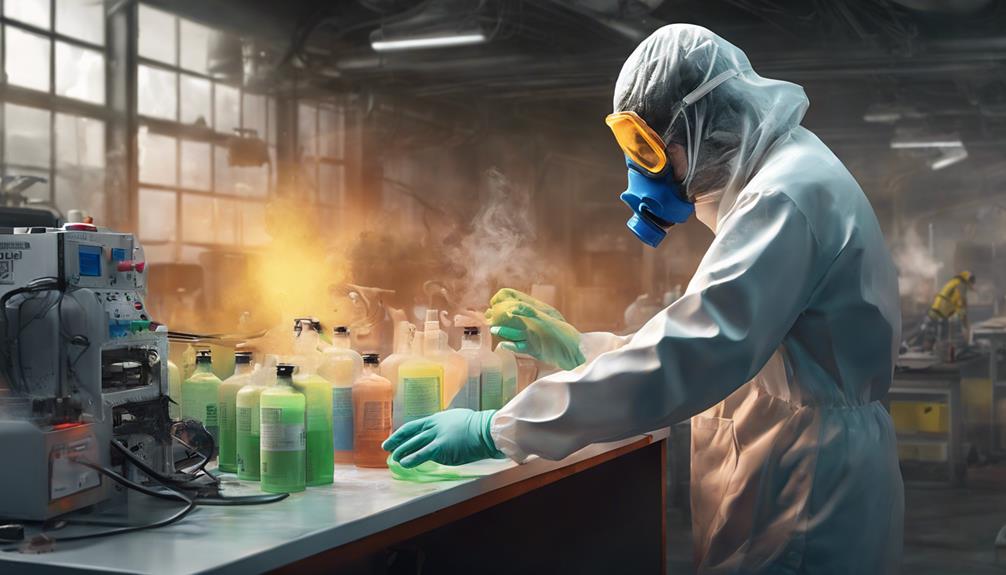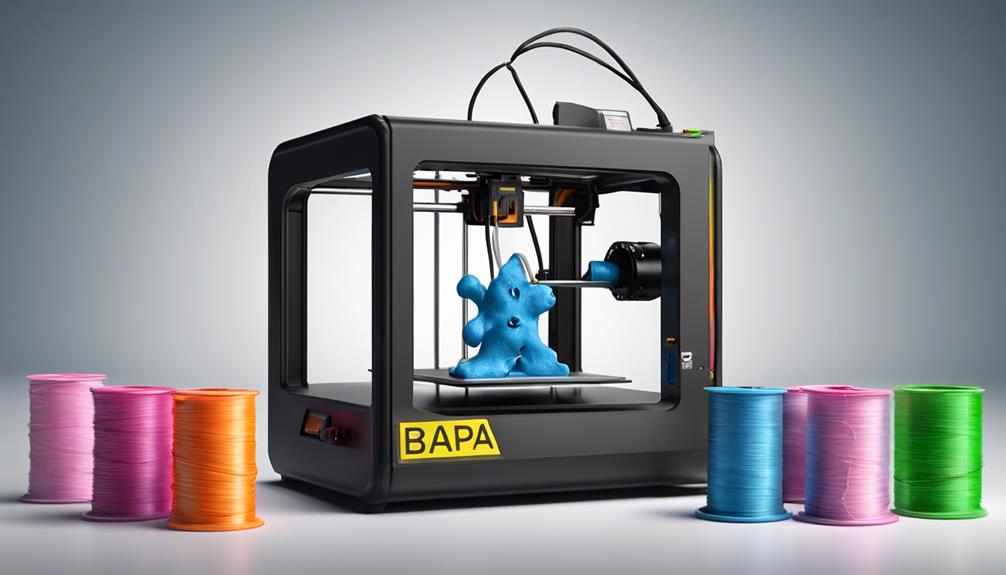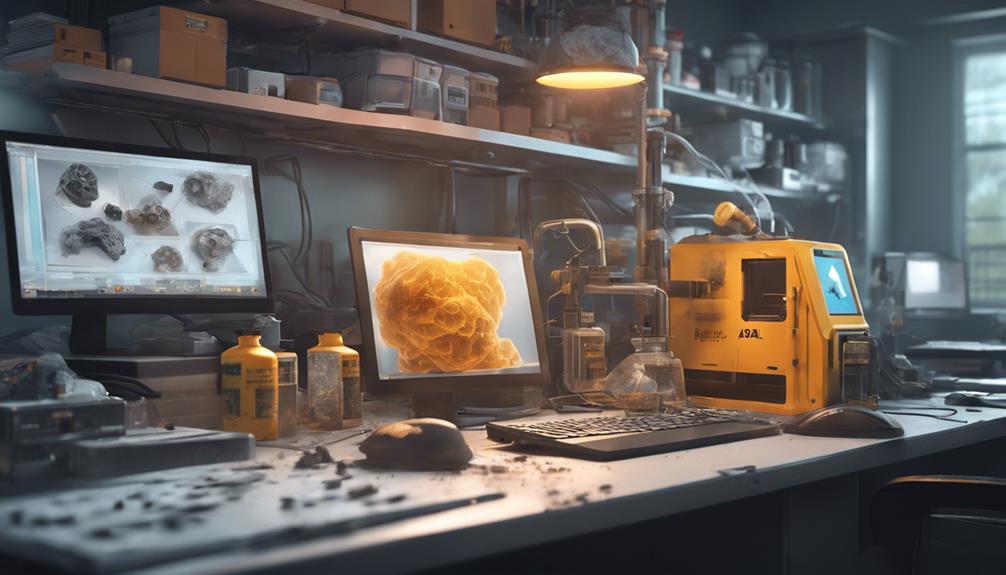The rapid expansion of 3D printing technology has brought about innovative opportunities but also raised concerns regarding toxicity risks associated with the process. As the demand for personalized manufacturing grows, so does the potential exposure to harmful emissions from printing materials. The intricate interplay between material composition and health hazards underscores the importance of understanding the nuances of toxicity in additive manufacturing. By exploring the intricate web of safety protocols, material choices, and emerging concerns, one can gain a deeper insight into the hidden dangers that permeate the domain of 3D printing.
Health Risks of 3D Printing Materials

The health risks associated with 3D printing materials, particularly those emitted from FDM printers, pose significant concerns due to the potential exposure to toxic particles that can lead to lung inflammation.
Among the materials used, ABS stands out as one of the most hazardous due to its emissions of toxic substances like Bisphenol A and acrylonitrile. PLA, while popular, emits high levels of ultrafine particles, with added additives potentially increasing its danger.
Nylon releases particles like styrene and caprolactam, linked to cancer risk and respiratory damage. On the other hand, PETG emits ultrafine particles but is considered chemically stable and non-toxic.
Understanding these risks is essential for implementing effective safety measures in the 3D printing environment.
Ventilation and Safety Measures
Implementing effective ventilation systems is vital for mitigating exposure to toxic fumes during 3D printing processes. Adequate ventilation helps in reducing the concentration of harmful particles in the air, safeguarding the health of individuals involved in or near the printing area.
Installing a particulate filter system with activated carbon can further enhance air quality by capturing and neutralizing toxic emissions. It is recommended to vacate the room while the printer is operational and ventilate the space afterward to minimize the risks associated with inhaling toxic fumes.
Additionally, considering that different colors of the same material may emit varying levels of toxic substances, it is essential to refer to safety information sheets provided by filament manufacturers for proper handling and precautionary measures.
Concerns About BPA in Filaments

Health risks associated with 3D printing materials, specifically the concerns surrounding Bisphenol A (BPA) content in filaments, highlight significant considerations for ensuring user safety in additive manufacturing processes. BPA, commonly found in ABS and HIPS filaments, poses health risks upon inhalation, emphasizing the importance of safety precautions when handling these materials.
PETG emerges as a popular BPA-free alternative for 3D printing, offering a safer option for users. Despite this, further studies are necessary to fully grasp the potential toxicity of BPA particles released during the printing process.
Ensuring awareness of filament composition and opting for BPA-free materials like PETG can mitigate health concerns and contribute to a safer 3D printing experience.
Food Safety and 3D Printing
Concerns about BPA content in filaments highlight significant considerations for ensuring food safety in 3D printing processes. When it comes to food safety and 3D printing, several key points must be taken into account:
- PETG and PLA are considered food-safe materials for 3D printing.
- Additives in filaments can impact food safety, especially when exposed to high temperatures.
- Polymers exposed to high temperatures may release harmful substances affecting food safety.
- Post-processing methods can help improve food safety by reducing imperfections and bacterial harboring in printed objects.
Toxicity Risks in SLA Printing

Ensuring safety in SLA printing requires strict adherence to protective measures due to the high toxicity risks associated with handling liquid resin. The chemicals present in SLA resins can lead to skin allergies or sensitivities, emphasizing the need for caution during the printing process. Proper ventilation and personal protective equipment are essential to minimize exposure to harmful substances. Additionally, the potential release of toxic compounds from SLA-printed objects raises concerns, particularly regarding food safety. Understanding and implementing safety protocols when working with SLA technology is paramount to safeguarding both personal health and the integrity of printed materials.
| Safety Measures | Importance |
|---|---|
| Ventilation | Minimizes exposure to fumes |
| Personal Protective Equipment | Prevents skin and eye contact |
| Controlled Environment | Reduces risks of toxic exposure |
| Safe Handling Procedures | Minimizes health hazards |
| Awareness of Risks | Promotes safe printing practices |
Frequently Asked Questions
Can 3D Printing Materials Cause Skin Allergies or Sensitivities?
Yes, 3D printing materials like SLA resin can cause skin allergies or sensitivities. It is vital to handle resin in controlled environments with protective gear. Safety precautions, such as gloves and eye protection, are essential to avoid exposure to toxic substances.
How Can I Ensure the Safety of Food Items 3D Printed Using Petg?
To guarantee the safety of food items 3D printed using PETG, prioritize using high-quality, food-safe PETG filaments. Implement proper post-processing techniques to minimize bacterial harboring. Adhere to recommended temperature guidelines to prevent the release of harmful substances.
Are There Specific Post-Processing Methods to Enhance Food Safety in 3D Prints?
Enhancing food safety in 3D prints involves methods like post-processing with sanding or sealing to reduce bacterial harboring. By treating prints like a chef garnishing a dish, ensuring smooth surfaces, one can serve safer creations.
Do Different Colors of the Same Filament Material Emit Varying Levels of Toxins?
Different colors of the same filament material in 3D printing may emit varying levels of toxins. This variation can be attributed to the additives used in pigments. Understanding the composition of each color is crucial for evaluating potential health risks.
What Are the Potential Long-Term Health Effects of Inhaling BPA Particles From 3D Printing?
Long-term health effects of inhaling BPA particles from 3D printing may include respiratory issues, hormonal disruptions, and potential carcinogenic risks. Safety precautions, like using BPA-free alternatives such as PETG, are advised to minimize health risks.
Conclusion
To sum up, the toxicity dangers associated with 3D printing materials highlight the importance of proper safety measures and awareness of potential health risks. Understanding the composition of filaments and choosing BPA-free alternatives like PETG can greatly reduce exposure to harmful substances.
One interesting statistic to note is that over 80% of 3D printing filaments contain potentially toxic compounds, emphasizing the need for caution and vigilance in utilizing this technology.